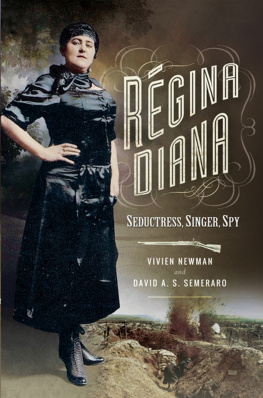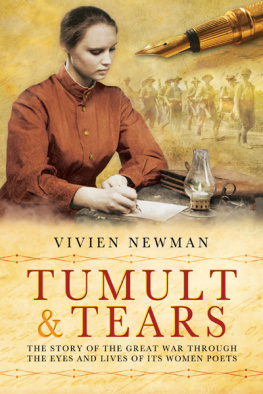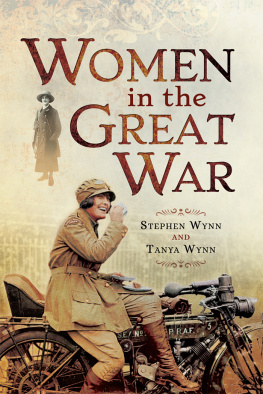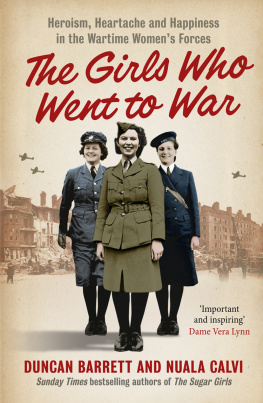Dedication
For Ivan, Rosalind and Elizabeth: thank you for never doubting I could do it.
This book is in memory of my Great War grandfathers: Major Arthur Scott-Turner, Surgeon, RAMC; Doughboy Percy Adler; my grandfather-in-law Private Samuel Newman of the Loyal North Lancashire Regiment; and also of my mother-in-law, Captain Edith Newman (ne Jacobs) ATS, who volunteered on 4 September 1939. If her brother could serve, so too would she!
First published in Great Britain in 2014 by
PEN AND SWORD HISTORY
an imprint of
Pen and Sword Books Ltd
47 Church Street
Barnsley
South Yorkshire S70 2AS
Copyright Vivien Newman, 2014
ISBN: 978 1 78346 225 4
EPUB ISBN: 978 1 47384 527 5
PRC ISBN: 978 1 47384 535 0
The right of Vivien Newman to be identified
as the author of this work has been asserted by her in accordance
with the Copyright, Designs and Patents Act 1988.
A CIP record for this book is available from the British Library
All rights reserved. No part of this book may be reproduced or
transmitted in any form or by any means, electronic or
mechanical including photocopying, recording or
by any information storage and retrieval system, without
permission from the Publisher in writing.
Printed and bound in England
by CPI Group (UK) Ltd, Croydon, CR0 4YY
Typeset in Times New Roman by
CHIC GRAPHICS
Pen & Sword Books Ltd incorporates the imprints of Pen & Sword
Archaeology, Atlas, Aviation, Battleground, Discovery,
Family History, History, Maritime, Military, Naval, Politics, Railways,
Select, Social History, Transport, True Crime, and Claymore Press,
Frontline Books, Leo Cooper, Praetorian Press, Remember When,
Seaforth Publishing and Wharncliffe.
For a complete list of Pen and Sword titles please contact
Pen and Sword Books Limited
47 Church Street, Barnsley, South Yorkshire, S70 2AS, England
E-mail:
Website: www.pen-and-sword.co.uk
Contents
Acknowledgements
My first and greatest debt is to the hundreds of women whose writings have enabled me to enter vicariously into their wartime lives. My aim has been to do them justice.
The interest, encouragement, and generous sharing of ideas of many friends and colleagues has sustained me during the writing of this book.
Debbie de Boltz ferried me around York Minster, willingly taking just one more photograph of the Memorial Panels.
Caroline Carr-Whitworth, Curator at Brodsworth Hall, graciously responded to my plea for entry to the Hall and provided so much information about eight-year-old Amy, her knitting and her letters.
Keith Dolan has shared his font of knowledge about the Western, and especially Gallipoli Fronts over many years; his abilities to bring campaigns to life and guide pilgrims round battlefields are second to none.
Colour-Sergeant Christopher Earl ferreted out obscure military information and provided insight into todays Armed Forces. I like to think that his being mentioned in the June 2014 Queens Birthday Honours is for his Meritorious Service to this book, but I understand it is in recognition of his dedicated military service.
Nelle Rote Fairchild, George Fletcher, Chris Went, and the New Zealand Granthams shared family history about Nurse Helen Fairchild, Lieutenant Arthur and WRAF Alice Armer, munitions worker Martha Alderson, and Alexandra and Hugo Grantham.
Dr Vicky Holmes ability to spot blogs, tweets and calls for papers started the whole project.
Dickie King kindly lent the WAAC uniform. My daughter who modelled it for a photograph in this book is less grateful!
Clare Russells endless enthusiasm for my women and their stories extended to going on a day trip to Brussels merely to visit a prison, a firing range, a tram-stop and a statue.
Lucinda Semeraro is always able to find the perfect translation from French into English. Her enthusiasm for her sisters book has been constant.
David Semeraro went beyond the call of duty in trying to find out information about Regina Diane; we almost found her at the eleventh hour and one day we will! His nursing knowledge has also been invaluable.
Brita Smith genealogy sleuth extraordinaire.
Jen Newby has been the perfect editor calm, encouraging and quick to respond to panic emails. My gratitude to her is immense; any faults that remain in the text are, of course, my own.
My daughters Rosalind and Elizabeths belief in their Funny Mummy is more sustaining than they realise. Their willingness to sacrifice their fashion principles to model First World War service womens uniforms is heartening.
Above all my wonderful husband Ivan: his love, technical abilities with websites, scanners and recalcitrant computers, know no bounds. Not only did he expertly play devils advocate as he read multiple drafts, but without his culinary skills I may have lived on bully beef throughout the writing of this book.
Illustration Acknowledgements
The Black Cat Women on War Work cigarette cards are in my personal possession; there is a family wartime connection to Black Cat and the former Carreras Ltd.
My thanks to: Sally Day for the photograph of her grandmother Mary Lampard who worked at Chilworth Munitions Factory; Frances Olley for the photograph of her family member sadly her name is now forgotten but she herself is not; Debbie de Boltz for the York Minster panel of womens names which forms the background of the book jacket; Ivan Newman for patiently scanning in hundreds of potential images.
Introduction
It used to be said that war did not concern women
(Queens Nurses Magazine October 1916)
I have always known about my grandfathers First World War service. Her fathers photograph was on my mothers bedside table, his eyes, haunted by all he had seen, staring into the middle distance. He was a Royal Army Medical Corps surgeon, specialising in abdominal wounds, and he served in France from November 1914. Like so many who returned, he spoke little about his war service, although post-war he worked with those still suffering from shell shock teaching my mother to drive in the grounds of one of the lunatic asylums he visited weekly.
Less is known about my fathers father. He was a Doughboy in the American Armed Forces, dying of Spanish influenza in early 1919. Widowed in her mid-twenties, by the time I knew her my American grandmother could remember nothing of the young husband who had left her with two small boys to bring up alone. My teenage grandfather-in-law served at Gallipoli and in Mesopotamia. He was Mentioned in Despatches and returned with a bayonet wound that never fully healed. It used to terrify his grandsons. His war-related drink problem marred his own and his descendants lives. These stories are typical; many of my generation are familiar with male ancestors war service. But they are only one part of a familys history: the part that is easy to trace.
As a child, I accepted that both the First and the Second World War in which my father served, also pictured in uniform on my mothers bedside table, were Mens Business. Then, one day, my nanny decided it was time I learnt to knit. Desperately unskilful, I tried distracting her and asked when she had learnt to do this complicated task: During the First World War, I was five and I had to knit a scarf for a soldier. Lots of little girls did. We knitted in school and couldnt go out to play until we had done enough rows. I thought about this. Was knitting all that women and girls had done in this distant war? I asked more questions, only to come up against a brick wall.
Although as young mothers my grandmothers would have been occupied with their families, what about their sisters, my great-aunts? What had they done in the War? My mother did not seem to know, indeed, nobody seemed to know or even appeared interested. They could tell me about women in the Second World War but not the one that had already gripped my imagination. In many ways, this book is the result of my ongoing attempts to find answers to those questions. While I never have discovered what my own female ancestors did, I know what they might have done and the early battles they would have fought in order to be able to do anything at all.










